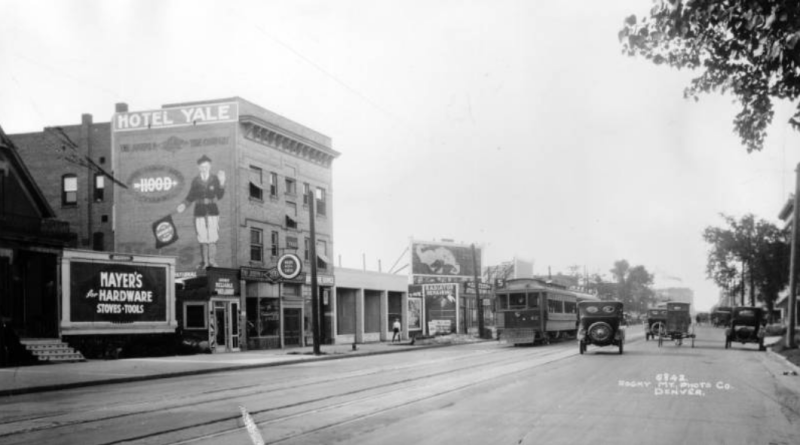Redesigning Broadway and Lincoln: Just the Latest Version of Evolving Streets

Denver’s streets are changing. City planners are converting one-way speedways into two-way neighborhood streets, prioritizing transit with more dedicated bus lanes, and installing more protected bike lanes. Meanwhile, City Council members seem to be taking people’s demands for sidewalks citywide seriously.
These changes don’t make everyone happy. The public’s limited street space “belongs” to cars, many argue. That’s just the way it’s always been. Except it’s not.
Take Broadway and Lincoln streets, where the Hancock administration wants to create more efficient dedicated bus lanes, reclaim a car lane to add a protected bikeway, and make crossings safer for pedestrians. These changes are just the latest iteration of streets that have changed, constantly, since the 1800s. The redesign is an evolutionary response to a growing city that will strangle itself with car traffic if it doesn’t prepare.
The redesign is also a return to Denver’s roots. There was a time, in the early-to-mid 1900s, when cars were the new mode on the block, and streetcars and bicyclists had to make room for them on South Broadway. Before the automobile, two north-south cable car lines clanged alongside horsecars on the street, until they rendered animal-powered transit obsolete in 1891.

It was actually bike advocates who started the push for paved roads in the Mile High City at the turn of the 20th century. “More than 25,000 of the city’s 133,859 residents were members of a local bicyclists’ organization, the Denver Wheelmen,” writes Owen Gutfreund, author of “Twentieth-Century Sprawl, Highways and the Reshaping of the American Landscape.” “Bicyclists convened a Good Roads Convention in October 1900, rallying for state and federal funding for roads” before nascent automobile organizations joined them and “quickly made their presence known.”
In the 1930s state and federal policies began heavily subsidizing infrastructure for the private automobile, incentivizing car-first planning from Denver’s city planners, “even through two-thirds of Denverites did not drive cars,” Gutfreund writes. “They relied on mass transit, which never received the same government support as private cars.” The extinct Denver Tramway Company once moved 36 million passengers a year, or about 250 trips per person.
In 1932 a planning document called for the removal of trolley tracks on major Denver streetcar routes because of “interference” with cars. The Denver Tramway Company gradually became a bus operator to take advantage of the publicly funded infrastructure for rubber-tire vehicles. Car-focused funding and planning finally ended Denver’s streetcar service in 1950. The South Broadway route was one of the last to go, according to a city document.
How road-crazy were Denver’s decision makers in the automobile era? Gutfreund found this hysterical, anonymous quote on the cover of a 1966 Denver Office of Planning document that gives you an idea:
Roads rule the world — not kings, nor courts, nor constables; not ships, nor soldiers. The road is the only legislature that never changes, the only court that never sleeps, the only army that never quits, the first aid to the redemption of any nation, the exodus from stagnation in any society, the call from savagery from any tribe… The road is umpire in every war and when the map is made it simply pushes on its great campaign of help, hope, brotherhood, efficiency, and peace.

Decisions about streets made back then came in response to a growing, changing city, just as they do today. Back then, “Denver was changing from an Old West mining town into a city of national importance,” writes Gutfreund. The result was an investment in much wider streets at the expense of fixed-track transit, sidewalks, space for bikes, and even front yards. Now the city is changing again — the population swelled by 83,000 between 2010 and 2015, according to the U.S. Census — but street space is finite.
Which brings us back to streets like Lincoln and Broadway. The question is not who the street is for, because it’s a public space — it’s for everyone. The question is, how can planners reorganize it to move everyone? For now, that means a bikeway, transit-only lanes, and bulb-outs to shorten crossings for people walking. For now.


